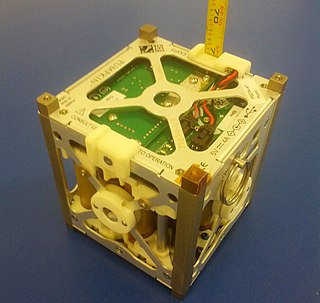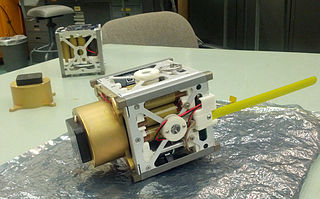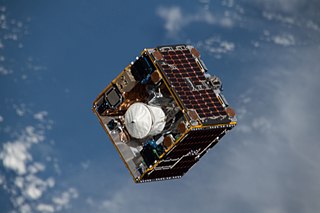Related Research Articles

A CubeSat is a type of miniaturized satellite for space research that is made up of multiple cubic modules of 10 cm × 10 cm × 10 cm size. CubeSats have a mass of no more than 1.33 kilograms (2.9 lb) per unit, and often use commercial off-the-shelf (COTS) components for their electronics and structure. CubeSats are put into orbit by deployers on the International Space Station, or launched as secondary payloads on a launch vehicle. As of 1 January 2021, more than 1350 CubeSats have been launched. More than 1200 have been successfully deployed in orbit and more than 90 have been destroyed in launch failures.
Technology Education Satellite (TechEdSat) is a class of CubeSats built by San Jose State University and University of Idaho students in partnership with NASA's Ames Research Center. These satellites have tested communication technology for smallsats, and have contributed to the development of the Small Payload Quick Return (SPQR) concept.
Goliat is the first artificial satellite developed in Romania.

PW-Sat is a series of satellites that includes the first Polish artificial satellite which was launched 13 February 2012 from ELA-1 at Guiana Space Centre aboard Italian-built Vega launch vehicle during its maiden voyage. PW-Sat1's mission was to test experimental elastic solar cells, as well as an orbital decay technology consisting of a "tail" designed to speed re-entry. It was expected to last for 1 year.

ESTCube-1 is the first Estonian satellite and first satellite in the world to attempt to use an electric solar wind sail (E-sail). It was launched on 7 May 2013 aboard Vega VV02 carrier rocket and successfully deployed into orbit. The CubeSat standard for nanosatellites was followed during the engineering of ESTCube-1, resulting in a 10×10×11.35 cm cube, with a volume of 1 liter and a mass of 1.048 kg.

Nanoracks LLC is a private in-space services company. Nanoracks is building tools to allow for the re-purposing of in-space hardware and turn it into agile space stations, which the company call Outposts.

Alexander, also known as PhoneSat 2.0 Beta or PhoneSat v2a is a technology demonstration satellite operated by NASA's Ames Research Center, which was launched in April 2013. Part of the PhoneSat programme, it was one of the first three PhoneSat spacecraft, and the first Phonesat-2.0 satellite, to be launched.

Graham, also known as PhoneSat 1.0a or PhoneSat v1a was a technology demonstration satellite operated by NASA's Ames Research Center, which was launched in April 2013. Part of the PhoneSat programme, it was one of the first three PhoneSat spacecraft to be launched.

Bell, also known as PhoneSat 1.0b or PhoneSat v1b was a technology demonstration satellite operated by NASA's Ames Research Center, which was launched in April 2013. Part of the PhoneSat programme, it was one of the first three PhoneSat spacecraft to be launched.

Planet Labs, Inc. is an American private Earth imaging company based in San Francisco, California. Their goal is to image the entirety of the Earth daily to monitor changes and pinpoint trends.

The Nanoracks CubeSat Deployer (NRCSD) is a device to deploy CubeSats into orbit from the International Space Station (ISS).
Spire Global, Inc. is a space-to-cloud data and analytics company that specializes in the tracking of global data sets powered by a large constellation of nanosatellites, such as the tracking of maritime, aviation and weather patterns.
EQUULEUS is a nanosatellite of the 6U CubeSat format that will measure the distribution of plasma that surrounds the Earth (plasmasphere) to help scientists understand the radiation environment in that region. It will also demonstrate low-thrust trajectory control techniques, such as multiple lunar flybys, within the Earth-Moon region using water steam as propellant. The spacecraft was designed and developed jointly by the Japan Aerospace Exploration Agency (JAXA) and the University of Tokyo.
OMOTENASHI is a small spacecraft and semi-hard lander of the 6U CubeSat format that will demonstrate low-cost technology to land and explore the lunar surface. The CubeSat will also take measurements of the radiation environment near the Moon as well as on the lunar surface. Omotenashi is a Japanese word for "welcome" or "Hospitality".

RemoveDEBRIS is a satellite research project intending to demonstrate various space debris removal technologies. The mission is led by the Surrey Space Centre from the University of Surrey with the satellite's platform manufactured by Surrey Satellite Technology Ltd (SSTL). Partners on the project include Airbus, ArianeGroup, Swiss Center for Electronics and Microtechnology, Inria, Innovative Solutions In Space, Surrey Space Centre, and Stellenbosch University.

Vega flight VV01 is the maiden flight of the Vega launcher. It occurred from the Centre Spatial Guyanais (CSG) on 13 February 2012 at 10:00:00 UTC.

Vega flight VV02 was the second flight of the Vega launcher. It occurred from the Guiana Space Centre on 7 May 2013 at 02:06:31 UTC.
A satellite dispenser is a space tug usually released from the upper stage of a rocket and designed to fly small secondary payloads to their desired location before deploying them.
References
- ↑ "D-Orbit Signs Contract for Launch and Deployment Services with Planet Labs – Parabolic Arc" . Retrieved 2019-03-19.
- ↑ "D-Orbit launches its first ION Satellite Carrier". www.spacenewsfeed.com. Retrieved 2020-11-17.
- 1 2 "D-Orbit brings tiny nano satellites to space for collecting climate change data". European Investment Bank. Retrieved 2021-05-17.
- ↑ "Mitigating space debris generation". www.esa.int. Retrieved 2021-05-17.
- ↑ Clark, Stephen. "Cluster of international satellites ready for ride into orbit on Vega rocket – Spaceflight Now" . Retrieved 2021-05-17.
- ↑ "D-Orbit Satellite Carrier delivers Planet SuperDoves to desired orbits". spacenews.com. Retrieved 2020-12-04.
- ↑ "Stories: Meet D-Orbit, the EIC-funded startup cleaning up space junk in orbit | European Innovation Council". community-smei.easme-web.eu. Retrieved 2021-05-17.
- ↑ "ION". InOrbit Now (in Italian). Retrieved 2019-03-19.